
Stages of labor
First stage of labor
The first stage of labor is divided into three phases: early, active and transition. The first stage of labor is when the cervix dilates (opens) to 10 centimeters.
Early labor
Early labor contractions pull on the cervix, which looks a bit like the neck of a turtleneck sweater. Contractions shorten or thin the cervix. This process is called effacement and is measured in percentages.
Your cervix starts out three to four centimeters long. When it is 50 percent effaced, it is about two centimeters long. When it is 100 percent effaced, it is "paper-thin."
Effacement can happen over days before labor starts. Or, it can happen over hours as labor progresses. With a first labor, it can take quite a while for the cervix to completely efface. Labor may start slowly because the cervix first thins and then dilates.
Dilation is measured in centimeters, one to 10. In general, early labor moves to active labor by about six centimeters (cm).
In early labor, you may only need to use distraction and relaxation techniques to help cope with any discomfort.
Active labor
During active labor, contractions are more regular and intense, and cervical change is more regular. Active labor, however, requires more coping skills. When contractions become longer, stronger, and closer together, the key to coping is to relax between the contractions. During the contractions do whatever technique helps you deal with them.
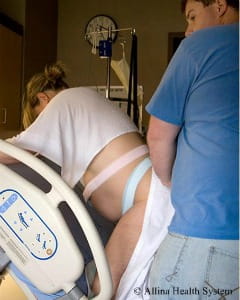
First stage active labor
Transition labor
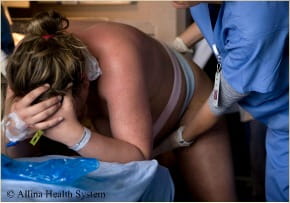
First stage transition
Second stage of labor
Second stage is the work of pushing your baby through your vagina (birth canal). It is more difficult than the distance suggests because your baby must turn to fit through your pelvis.
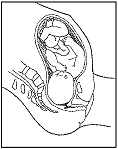 |
|
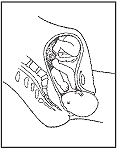 |
 |
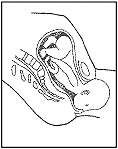 |
|
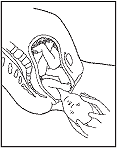 |
|
|
Third stage of labor
The third stage is the shortest and easiest. It is the delivery of the placenta.
Stages of labor: What happens, how it feels
| Stage or phase | What happens during labor | How it feels |
|---|---|---|
|
First stage Early phase |
|
Each phase feels different. Contractions are mild to strong. You may feel comfortable between contractions. You may feel nervous, nauseated or excited. Try to relax and work with the rhythm of your body. |
| Active phase |
|
Contractions are stronger. Your attention is focused inward. You may have a dry mouth, chills and nausea, or feel sweaty. Concentrate on staying relaxed between contractions to conserve your energy. It is important to move and switch positions throughout labor to help your baby descend and get in a good position for delivery. |
| Transition phase |
|
Contractions are intense and close together. You may have hiccups, nausea, vomiting, shaking and pelvic pressure. You may feel like giving up. Take one contraction at a time. |
| Second stage (pushing) |
|
You may experience a "rest period" before you feel an urge to push. You might get a surge of energy. Pushing can feel like pressure, stinging, burning or pain. Pushing can take a long or a short time. This depends on the position of your baby, the effects of medicine, and how well you are able to push. Focus on using your abdominal muscles to push down, out and away. Your health care team will help suggest positions and techniques to aid you in your pushing efforts. |
| Third stage (after birth) |
|
Contractions are less intense and may even be easy while you expel the placenta. Push gently when your health care provider asks you to do so. |
Related resources